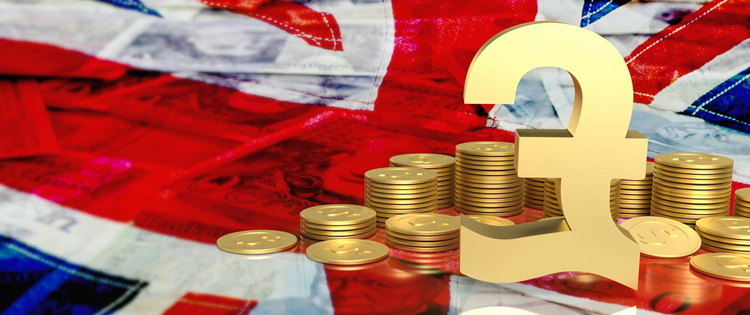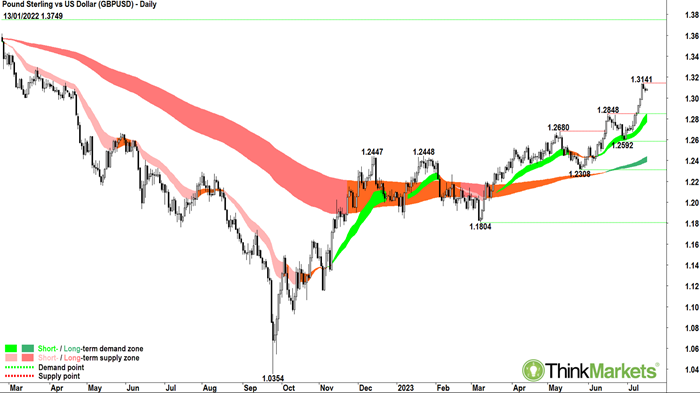

Download Carl’s Bear Market Survival Guide e-Book:
https://www.thinkmarkets.com/au/lp/2023-bear-market-survival-guide-ebook/

If there’s one major Western economy which has been struggling with acutely high inflation, it’s the UK. Economists are predicting a decline in the annual rate of inflation within the UK economy this week, but if it does hit their expectations of 8.2% p.a., it will still be well above the Bank of England’s (BOE) 2% target and well above inflation in other developed economies.
June’s expected 8.2% p.a. consumer price inflation (CPI) print will be a decline of 0.5% p.a. from May’s 8.7% p.a., and modestly lower than the 11.1% p.a. peak logged in April. Compare this to the 5.5% p.a. rate logged in the Eurozone’s most recent CPI, and a sharply lower 3% CPI print in the USA last week, and it is fair to assume any UK CPI print with an “8 in front of it” will cause continued concern at the BOE.
The key to June’s US CPI, to be released at 06:00 UTC on Wednesday, will be just how much impact falling fuel prices have. Most estimates assume approximately a 2% drop in fuel prices for the month, and this will assist the deflationary process. However, other key consumer items such as food (likely up over 15% p.a. to June) and rents (likely to creep to over 5% p.a. to June) continue to put pressure on household spending and potentially further feed inflationary expectations.
UK and US rates divergence to continue
The BOE increased its official cash rate by 0.5% to 5% p.a. earlier this month. This was ahead of market expectations for a 0.25% hike. Clearly the BOE sees the urgency here, and it is probably the most committed and most likely of the major central banks to continue to increase interest rates throughout the back half of 2023. Indeed, many economists now predict that the BOE official rate could peak around an eye watering 6.5% p.a. by the end of this year.
With the Fed in the USA likely to either pause at next week’s meeting, or at worst deliver what markets are growingly describing as a “one and they’re done” further 0.25% hike, it is clear the relative path of interest rates in the UK and US is one of divergence. This bodes well for continued GBPUSD strength.
How to trade Wednesday’s UK CPI
Traders should be predisposed to GBPUSD longs, in line with the clear short-and-long-term uptrends (light and dark green ribbons). It makes sense that any UK CPI print greater than 8.2% p.a. will likely reaffirm the thesis of higher rates in the UK vs US in the medium term, and therefore bolster the GBPUSD. Alternatively, a sharper decline, particularly with a seven handle, would spark at least modest profit taking, and trigger a downward correction in the GBPUSD.
Key price points to watch out for include 1.2848 to the downside. I expect to see substantial in-trend demand there (so watch for long-side trading opportunities). Contrasting this, there are few clear supply points to the upside. I expect only minimal supply at 1.3141, and there’s 5-odd figures to the next major potential supply point at 1.3749.
Wednesday’s UK CPI print is certainly what forex traders call a “live data point”. Expect it to be closely watched, and potentially, we are primed for a substantial market reaction through the GBPUSD. Volatility can be a double-edged sword, however, creating both risks and rewards. So be sure to keep a tight rein on your risk management parameters if you intend to trade this week’s UK CPI.

Learn More, Earn More!
Want your portfolio questions answered? Register for next week’s Live Market Analysis sessions and attend live! You can ask me about any stock, index, commodity, forex pair, or cryptocurrency you’re interested in.
You can catch the replay of the last episode of Live Market Analysis here:
Bulls on the charge! We find the buys in USA stocks







